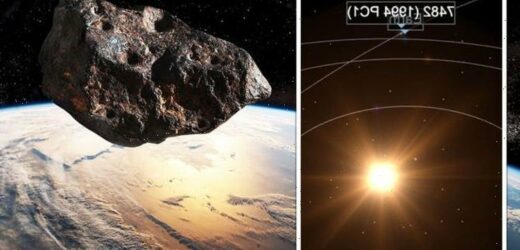NASA test planetary defence spacecraft to divert asteroid's path
We use your sign-up to provide content in ways you’ve consented to and to improve our understanding of you. This may include adverts from us and 3rd parties based on our understanding. You can unsubscribe at any time. More info
Asteroids infrequently pass the Earth, with some close shaves detected over the last few years. The hulking mass of space rock will pass the planet today is 1.1km long and goes by (7482) 1994 PC1. When it swings by, it will do so from a safe distance and in range of space monitors.
How can you watch (7482) 1994 PC1?
The incoming asteroid was first discovered nearly 30 years ago by astronomer Robert McNaught, who caught a glimpse of the rock on the night of August 9, 1994, from the Australian Siding Spring Observatory.
The asteroid enters the Earth’s line of sight once every 572 days and is forecast to appear today.
PC1 – which has been dubbed “potentially hazardous” – will approach within 1.2 million miles of the Earth’s atmosphere, getting closest a couple of hours before midnight.


Despite its designation, the Earth is in no danger from the rock, which scientists believe is approximately two times the size of the Empire State Building.
People looking for it should find it in the night’s sky around the border of the Cetus and Pisces constellations.
The asteroid will follow its path through the sky at a speed of approximately two degrees per hour.
That speed should help budding astronomers spot it as it moves through the sky.

PC1 will loom in the sky for some time and remain observable into the early hours of January 19, but by then, it will be less visible, having drifted out approximately 1.7 million miles.
Observers will need a capable telescope pointed at the correct coordinates.
Those living in Africa and Europe will have the best views, but 1994 PC1 should appear in range of North Americans as well.
Conditions won’t favour everyone, as some astronomers may find their views blocked by local weather.

They don’t have to miss out, as there is a live stream scheduled tonight.
The Virtual Telescope Project, which compiles feeds from remotely controlled telescopes, will stream the asteroid live tonight.
Their stream starts at 8pm and is available here (Virtual Telescope’s WebTV – The Virtual Telescope Project 2.0), but people who can’t make it tonight have other asteroids to watch later in the year.
Scientists have tipped two more to make a “close approach” later this year.
They include 2020 TO2 and 2015 RN35 due on October 15 and December 15, respectively.
They can also catch the following meteor showers:
Lyrids: April 22 to 23
Eta Aquariids: May 6
Delta Aquariids: July 30
Alpha Capricornids: July 30
Perseids: August 12 to 13
Draconids: October 8 to 9
Orionids: October 21 to 22
Taurids
- Southern: October 10 to 11
- Northern: November 12 to 13
Leonids: November 17 to 18
Geminids: December 14 to 15
Ursids: December 22 to 23
Source: Read Full Article


